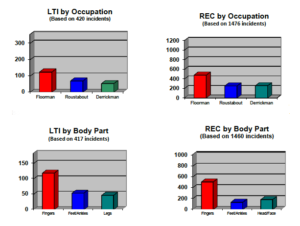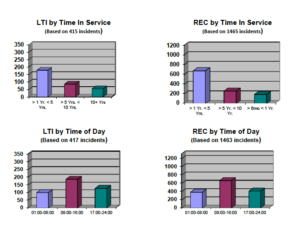2015 ISP: Fatalities fall from 21 to 8; LTI, recordable incidence rates both down by approximately 20%
For first time since IADC started ISP in 1962, US onshore drilling contractors reported zero fatalities
By Linda Hsieh, Managing Editor

The global drilling industry reported eight fatalities in 2015, according to the most recent report from the IADC Incident Statistics Program (ISP). That is a significant improvement over the 21 fatal incidents reported in 2014. In particular, ISP data showed that – for the first time since the program started in 1962 – US onshore drilling contractors reported zero fatalities. “It’s an achievement worth celebrating and shows that all the efforts that onshore drillers have been putting in to improve safety are paying off,” Rhett Winter, IADC Director of Onshore Operations, said.
In terms of lost-time incidence (LTI) and recordable incidence rates, the industry also saw improvements. The global drilling industry reported a 0.18 LTI rate for 2015, which represents a 21.74% reduction from the 2014 rate of 0.23. The recordable incidence rate also improved by 20%, decreasing from 0.75 to 0.60.
During 2015, a total of 103 drilling contractors, representing 500.6 million manhours worked, participated in the ISP. These companies reported a total of 431 LTI incidents, including eight fatalities, and 1,511 recordable incidents over the course of the year. The ISP report is based on incidence rates, which are calculated on incidents per 200,000 manhours.
Fatalities

Looking at the eight fatalities by the employees’ years of service, the top category was employees with between one to five years of service; they accounted for three of the eight fatalities. By activity, travel/transportation accounted for the most fatalities, while “struck-by” was the top category in terms of incident type. By employee occupation, the fatalities were split evenly among floormen, drillers/assistant driller and truck drivers, each accounting for two deaths. See Figure 1 for a breakdown of 2015 fatalities.
Region by region
US
In the US, onshore and offshore contractors worked a combined 95.9 million manhours in 2015. The single fatality reported in this region came from offshore, which accounted for 37.89 million manhours worked. Offshore contractors’ LTI rate improved by 14.2%, decreasing from 0.14 in 2014 to 0.12 in 2015. Their recordable rate improved by 12.5%, falling from 0.64 to 0.56.
US onshore contractors accounted for 58 million manhours worked. Their LTI rate fell from 0.41 in 2014 to 0.31 in 2015, representing a 24.4% improvement. Their recordable rate also went down, from 1.54 to 1.22, for a 20.7% improvement.
Europe

European contractors worked a total of 79.4 million manhours in 2015. Both fatalities that were reported in this region came from the onshore sector.
Onshore contractors in this region worked 42.9 million manhours and were able to improve their LTI rate by 37.5%, nudging it down from 0.24 to 0.15. Their recordable rate improved similarly, decreasing from 0.35 to 0.23 for a 34.3% reduction.
European offshore contractors worked 36.5 million manhours and held their LTI rate steady at 0.19 from the past year. Their recordable rate went down by 13.7%, from 0.73 to 0.63.
Canada
There were zero fatalities reported in Canada during 2015 while nearly 2.97 million manhours were worked.

Canadian offshore contractors accounted for 1.49 million manhours worked. The LTI rate in this sector remained unchanged from 2014, at 14.3. However, their recordable rate worsened by 14.3%, increasing from 0.70 in 2014 to 0.80 in 2015.
Onshore, contractors worked 1.47 million manhours and were able to improve both their LTI and recordable rates. The LTI rate went down from 0.29 to 0.14, for a 51.7% improvement, while the recordable rate went down from 2.33 to 1.36, for a 41.6% improvement.
Central America and Caribbean
A total of 9.22 million manhours were worked in this region, with zero fatalities overall.
Offshore contractors in Central America and the Caribbean worked 5.56 million manhours. Their LTI rate went down by 47%, falling from 0.34 in 2014 to 0.18 in 2015. Their recordable rate went down from 0.90 to 0.61, a 32.2% improvement.

Onshore contractors in this region, in contrast, saw both their LTI and recordable rates worsen during 2015, with 3.66 million manhours worked. Their LTI rate went up from 0.43 to 0.98, for a 127.9% increase. Their recordable rate went up by an even larger 144.6%, going from 0.65 in 2014 to 1.59 in 2015.
Africa
Drilling contractors in Africa worked a total of 57.6 million manhours in 2015, and all three fatalities in this region came from the onshore segment.
Onshore contractors worked a total of 29.73 million manhours and saw their LTI and recordable rates worsen. Their LTI rate went up by 21.8%, from 0.32 to 0.39, while the recordable rate went up by 11.5%, going from 1.04 to 1.16.
In the offshore sector, African contractors worked a total of 27.9 million manhours and were able to halve their LTI rate, going from 0.18 to 0.09. Their recordable rate improved by a similar 47.7%, going from 0.65 to 0.34.
Middle East

This region, which has remained among the most resilient during this market downturn, reported a total of 145.4 million manhours worked in 2015. Both fatalities in this region came from the onshore segment.
Onshore contractors in the Middle East worked a total of 103.46 million manhours and kept their LTI rate the same from 2014, at 0.14. Their recordable rate worsened by 11%, increasing from 0.54 in 2014 to 0.60 in 2015.
Offshore contractors in the region accounted for 41.9 million manhours worked. Their LTI rate worsened by 25%, rising from 0.08 to 0.10. Their recordable rate, however, improved by 11.4%, falling from 0.35 to 0.31.
Asia Pacific
This region accounted for a total of 61.7 million manhours worked, with no fatalities.
Offshore contractors worked 44.51 million manhours and improved their LTI rate by 66.6%, which fell from 0.15 to 0.05. Their recordable rate improved from 0.40 to 0.23, a 42.5% reduction.
Onshore in the Asia Pacific, contractors worked 17.14 million manhours. They improved their LTI rate from 0.24 to 0.11, representing a 54.2% improvement. They also improved their recordable rate, which fell from 0.45 to 0.34, for a 24.4% reduction.
South America
South American drilling contractors worked a total of 41.6 million manhours, with zero fatalities overall.
LTI and recordable rates, unfortunately, both worsened for onshore contractors in this region, who worked 22.37 million manhours. The LTI rate increased from 0.19 to 0.25, a 31.6% difference. The recordable rate increased from 0.54 to 0.72, for a similar 33.3% difference.
Offshore, contractors worked 19.21 million manhours and were able to improve their LTI rate by 15.4%, reducing it from 0.26 to 0.22. Their recordable rate saw a slight improvement of 3.7%, falling from 0.54 to 0.52.
Australasia
This region accounted for approximately 6.5 million manhours worked, with zero fatalities.
Onshore contractors worked 2.6 million manhours and improved their LTI rate from 0.23 to 0.15, a 34.7% decrease. They also decreased their recordable rate, from 1.37 to 0.53, a 61.3% improvement.
Offshore, Australasian contractors worked 3.9 million manhours. A 66.6% increase in their LTI rate was observed, which went up from 0.06 in 2014 to 0.10 in 2015. Their recordable rate improved by 9.8%, going from 0.61 to 0.55. DC
Click here for more information about participating in the IADC ISP.




